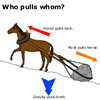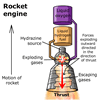(Newton's 3rd law)
"To every action there is an equal and opposite reaction."
Newton's 3rd law of Motion deals with the way objects interact with each over. When you hold a weight in your hand, for example, the weight pushes down on your hand and your hand pushes up on the weight with an equal and opposite force. If you take your hand away, the weight will fall the floor, accelerating due to the gravitational force.

|
The effect of gravity |
In Newton's own words
(To be read only for historical insight. The mixture of old English and
terminology can confuse!)
To every action there is always opposed an equal reaction; or the
mutual actions of two bodies  upon
each other are always equal and directed to contrary parts.
upon
each other are always equal and directed to contrary parts.
What ever draws or presses another is as much drawn or pressed by the other. If you press a stone with your finger, the finger is also pressed by the stone. If a horse draws a stone tied to a rope, the horse (if I may say so) will be equally drawn back towards the stone. "Principia - 1726"
Rockets and the 3rd law
A rocket is a spectacular example of Newton's 3rd law, where hot gases
produced in the rocket's combustion chamber push outwards in all directions
on the sides of the chamber. If the chamber were completely closed on
all sides the rocket would not operate. However because there is an opening
at the rear of the chamber, the expanding gases cannot exert a force in
the direction of the opening. Therefore the unbalanced force on the front
of the chamber can thrust the rocket forward and up.
The rocket simultaneously exerts a force on the gas which expels the
gas from the rocket engine. The force of the rocket on the gas and the
the force of the gas on the rocket are equal in magnitude but opposite
in direction.

|
Newton's third law |
Measuring equal and opposite forces
 A
simple way of demonstrating the working of Newton's 3rd law is to join
the hooks of two spring balances together and
pull the two ends apart. When pulled apart they will both register the
same magnitude of force, but in opposite directions. Whether both ends
are pulled or one end is attached to a wall and the other spring pulled,
the two springs will register equal and opposite forces.
A
simple way of demonstrating the working of Newton's 3rd law is to join
the hooks of two spring balances together and
pull the two ends apart. When pulled apart they will both register the
same magnitude of force, but in opposite directions. Whether both ends
are pulled or one end is attached to a wall and the other spring pulled,
the two springs will register equal and opposite forces.
| Copyright owned by the State of Victoria (Department of Education and Early Childhood Development). Used with Permission. |